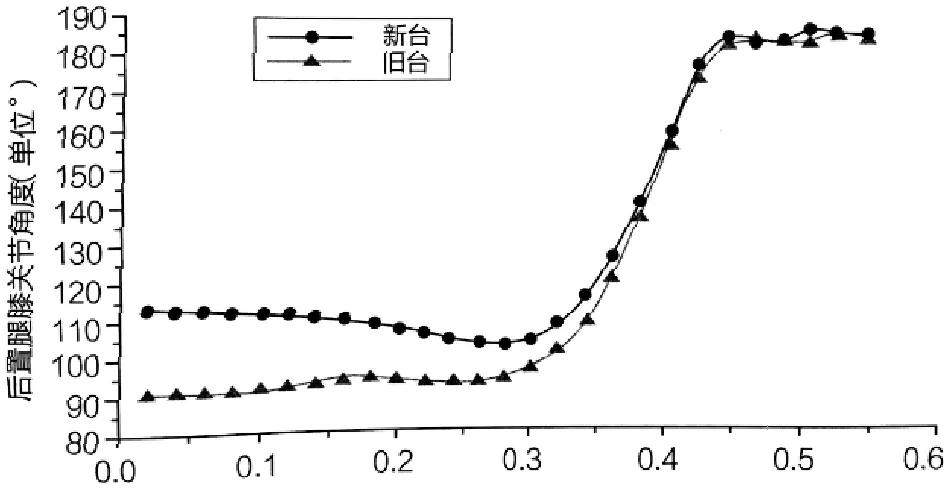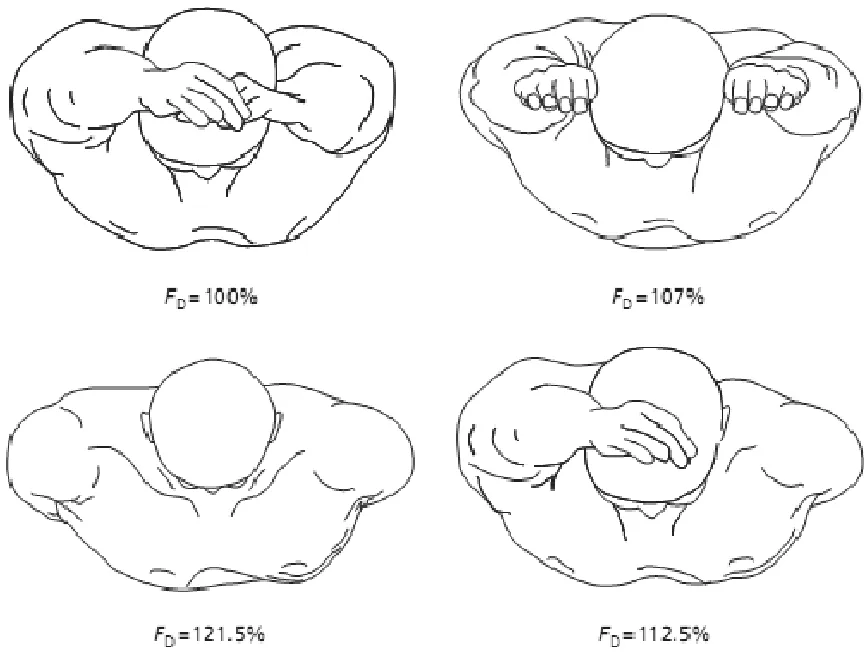游泳出发阶段的运动学研究进展
2016-10-26邵严昊顾耀东李建设
邵严昊,顾耀东,,李建设
(1.宁波大学 体育学院,浙江 宁波 315211;2.宁波大学 大健康研究院,浙江 宁波 315211)
·运动生物力学·
游泳出发阶段的运动学研究进展
邵严昊1,顾耀东1,2,李建设2
(1.宁波大学 体育学院,浙江 宁波 315211;2.宁波大学 大健康研究院,浙江 宁波 315211)
随着对游泳的研究不断深入,出发阶段对比赛成绩影响的研究逐年增加。运动生物力学在出发阶段技术动作分析中起到重要作用,文章总结了大量国内外相关文献,从生物力学角度综述出发阶段的技术动作特征,并重点探讨出发前15m各个阶段之间肢体配合对竞赛成绩的影响。旨在加强教练员与运动员对出发阶段技术训练的重视,同时帮助运动员优化技术动作提供理论依据。
生物力学;游泳;竞赛成绩;技术动作;适应性变化
0 前 言
游泳比赛是由出发、途中游、转身、终点冲刺和到边技术5个环节组成,游泳出发阶段作为第一个环节十分重要,在比赛中把听到发令枪响到头部游进前15m标志线作为完整的出发阶段,这段距离占到50m泳道的30%,在以百分之一秒决定胜负的短距离游泳比赛中出发技术直接影响着比赛的名次和成绩。在刚刚过去的2015年喀山游泳世锦赛男子50m自由泳决赛前三名的成绩仅仅相差0.36s,100m自由泳决赛冠亚军的成绩也仅相差0.11s,而在2012年的伦敦奥运会男子100m自由泳冠亚军的成绩更是以0.01s分出的胜负,可见技术细节的保障非常重要。随着游泳比赛影响力的日益增强、运动员整体水平的提高、比赛激烈程度的加剧,现代游泳相关研究的范围也越来越广泛,并且呈明显加快的趋势[42]。2015年喀山世锦赛,一种针对蹲踞式出发技术应运而生的 “可调节后蹬板”出现在大众视野。比赛中游泳出发阶段技术的研究参数主要包括:出发阶段时间(出发前15m时间)、转身时间(碰墙转身前7.5m)、末尾阶段时间(距墙5m)、游泳的距离、划水频率和速度[36]。此外,还要对出发阶段、转身和末尾阶段时间对比赛成绩的作用进行定量评估[1,17,29,39,59]。对短距离比赛数据的统计分析结果表明,发现出发前15m时间约占比赛时间总数的0.8%到26.1%[29]。研究指出,游泳运动员能否高效利用潜水技巧在入水滑行阶段生成较高速度将对比赛的每个阶段产生影响[25,30]。
1 文献检索与筛选
本文以运动学(kinematics);竞赛成绩(performance);技术动作(technique);适应性变化(variability);游泳(swimming);出发(start)为关键词在MEDLINE、ScienceDirect OnLine、CNKI和谷歌学术数据库中进行检索。通过对所有检索到的文献进行整理分类,最终筛选出67条文献引用。
2 游泳出发阶段技术的运动学分析
研究选取29种变量:8种时间,7种角度,14种速度[4]。在分析游泳出发阶段动作表现的运动学参数时,为便于研究通常把出发阶段分成不同阶段,可分为台上时间、腾空时间和水下时间[6,1,18,57]。最近的研究认为,出发阶段是从听到开始信号开始到离开泳台的时间[7,8,49]。以上研究采用安装在与运动方向垂直的数码摄像机进行采集,与此不同,Vantorre等[52]使用两台固定摄像机,一台安装在游泳出发处,另一台安置在出发15m处,机高2.5m,距离泳池5m远的地方,在一定范围内使用水下移动相机测量划水长度和频率。另有大量研究利用特制泳台记录从预备动作到离开泳台这段时间推进力的变化,并对泳台起跳过程进行动力学量化分析,绘制泳台起跳阶段的作用力曲线[7,11,27,49,54,55,59,63]。
2.1泳台起跳阶段
随着时间的推移和科技的进步,游泳出发技术经历了几次技术革新,从最初的“摆臂式”到“抓台式”,再到目前使用最普遍的“蹲踞式”。游泳出发阶段的动力学研究指出,从听到开始信号到离开泳台的阶段与田径比赛的起跑阶段十分相似[2,24,27,38,59,65]。然而从生物力学角度来看,即使在相同阶段仍然有许多方面不同。由于运动员之间的个体差异和不同特长,在出发阶段的动作也有所不同。短距离游泳运动员需要触墙向后转身使自身继续向前游,而长距离游泳运动员则需要注意比赛距离、在水面上的时间和每次入水时身体的方向。需要指出的是,分解出发阶段不仅是个空间问题,而且是关于整个开始阶段运动期间动力系统变化的问题。对泳台阶的相关研究[7,52,67]表明,听到开始信号的快速反应和泳台上生成向前冲的初速度是决定整体速度的两个关键因素。此外,成人运动员将后蹬板设置在第4、5档位时,其离台的水平速度、后置腿的最大力量等方面都显著高于前三个档位,这与运动员的身高、下肢长度等个体差异也有一定关系[66]。游泳运动员不仅在起跳阶段的反应要更加迅速,而且从泳台起跳到入水滑行的时间段需要获得足够大初速度和加速度[13]。换句话说,需要在泳台上花足够的时间产生更大的作用力并尽可能快地离开泳台[31]。有研究建议运动员在准备起跳时前置腿的膝关节角度以135~145°为宜,后置腿的膝关节角度以100~110°(水平速度更大)或80~90°(更能发挥后置腿的垂直蹬伸力量)为宜[67]。
与传统的抓台式出发不同(图1),新的蹲踞式出发技术在预备阶段就预先调整好了身体重心,能够尽量缩短缓冲时间快速进入蹬伸发力阶段,并减少台上用时[66]。以自由泳为例,2015年喀山世锦赛6个自由泳单项决赛前八名运动员,反应时(Response time: R.T.)的平均成绩比2009年采用旧出发台时的R.T.的平均成绩总体缩短了0.05s,其中后蹬板促进后蹬力量的增加及身体重心的变化等都对R.T.成绩产生了直接影响。

图1 同一名运动员的后置腿膝关节在新、旧泳台上的角度变化
2.2腾空阶段和入水阶段
出发阶段的动作分解标准一直是不明确的。Maglischo[41]把手碰到水时称为入水阶段的开始,这个定义也广泛用于确定腾空阶段末尾的指标。游泳运动员需要在泳台起跳阶段获得足够大的初速度以帮助腾空阶段获得最大限度的跳跃距离[23,46]。Barlow H等[66]认为腾空时间不应算作出发阶段的时间,但是腾空跳跃的距离仍是决定出发阶段表现的变量之一(r = -0.482)。Maglischo[41]指出腾空阶段使用屈体姿势或平展姿势都会强烈影响运动员身体在空中的轨迹,屈体姿势比平展姿势有更久的滞空时间、更好的起跳与入水角度和更快的入水速度。Wilson和Marino[64]研究中发现屈体姿势比平展姿势有更短的出发前10m运动时间、更好的入水角度、更短的入水距离和以更好的髋关节角度入水。Kilduff 等[25]研究称,在出发前8m的时间内抓台式出发——平展姿势比抓台式出发——屈体姿势的入水角度更小,时间也更短。因此,平直姿势入水的目标是为了快速入水时保持更平滑的身体姿势并更早开始划水动作。屈体姿势是为了入水时能够产生更小的水花获得更快的速度。Vantorre[52]等指出,多数精英运动员的出发技战术各不相同,个体差异性主要体现在如何通过控制肢体动作来达到独特风格的出发轨迹。以Volkov 出发动作为例,腿蹬水时手臂向后划,或腾空时手臂立即伸至头前[52-55]。然而,游泳运动员的在腾空阶段的目标不仅是跳跃距离达到最大化。Mclean[37]和 Vantorre[53]等指出,游泳运动员必须有足够的角动量才能做出一个标准的入水动作,这意味着他们需要足够的时间来调整身体姿势,从产生的水洞入水,习惯上称为洞式入水。手臂的动作会影响游泳出发阶段向前调整的角动量,向前摆臂是为使身体减少旋转,与之相反向后摆臂会增加身体的旋转。因此,为使用入水前产生更大的角动量,游泳运动员可以作一个平直的起跳(较小的角动量和一个平直的轨迹),或者做一个向后摆臂的Volkov出发动作(较大的角动量和一个抛物线轨迹)[47,56]。
2.3水下滑行阶段
水上动作(泳台,腾空,入水阶段)完成后,游泳运动员必须处理好从空中到水中动作姿势的过渡。头钻入水中滑行开始,头钻出水面滑行结束。在入水之后,游泳运动员想要尽可能维持前一阶段中获得的初速度就要保持稳定流线型的姿态并逐步转化为水平姿势,这一阶段称为入水滑行阶段。Cossor等[16]和Sanders等[45]研究指出,比赛成绩与出发阶段中水下滑行时间高度相关。然而,很少有研究能准确测量出两者间的相关程度。Guimaraes和 Hay[20]指出,出发阶段的水下滑行时间比泳台起跳时间或腾空时间对比赛成绩的影响更大。维持稳定流线型的姿态入水对减缓初速度的损失至关重要。有充分的证据显示,入水后游泳运动员被动前进时,仰卧位会比俯卧位产生更大的阻力[14,18]。这些观察结果表明,相比于身体表面积,身体形态在决定总的阻力比重上所起的作用更大。例如,双手相握叠时比双手与肩膀呈直线平行时阻力相对减少7%[10](图2)。鉴于出发阶段的重要性,一些研究人员提出了采用流体动力学分析量化滑行时质量与阻力系数的方法。滑行的阻力要素以及额外增加的质量是影响衡量滑行效率的指标[40,41,58]。Bixler等[9]在游泳研究中验证了这一方法。滑行的特性体现在运动员采用的姿势及身体周围水流流动特性两方面。滑行的要素(单位为m)是当一个滑行的躯体(游泳运动员)达到一个2m/s的初速度然后在0.5s后减速到1 m/s之间的距离。 Naemi和Sanders[41]表示这与运动员的体型有关系。流线型的躯体的惯性和水中阻力的特性会影响到滑行效率。一项关于蛙泳出发阶段过程中相同阶段平均滑行速度(1.37±0.124m·s-1)的研究发现,第一次划臂前第一阶段位置滑行的值明显低于蛙泳在水下第二阶段位置滑行的值。这也印证了Seifert等[47]关于蛙泳运动员趋向于在蛙泳出发阶段的第二阶段位置花费时间更多的观点。

图2 在被动前行时不同姿势对应的流体阻力(以滑行时双手相握比双手与肩膀呈直线平行为基准的百分比[10] )
2.4水下运动
在水下阶段,游泳运动员必须控制入水滑行,水下蹬脚以及划出水面的三个阶段的时间[19,34,52]。根据国际泳联规定,除蛙泳外的游泳出发阶段不仅局限在泳台起跳和空中阶段,还要持续到游泳运动员入水滑行后再次浮出水面游泳前行到达15m的标志处为止。然而即使入水滑行阶段在比赛开始贡献了很大的距离,特别是蛙泳,出发阶段的水下部分的研究仍然十分稀少[1,16,20,59]。Cossor和 Mason[16]通过对100m仰泳和100m蛙泳比赛出发阶段的研究发现,水下速度和出发前15m的平均速度呈负相关(r=-0.734)。研究者普遍强调量化出发阶段水下部分的重要性,但相关研究较少[10,15,19,32,33,50]。一些研究者们认为,高效的水下滑行阶段是良好游泳出发阶段的基础[45,59,60]。Pereira 等[43]的研究表明,在从入水到15m标记处之间的时间是在游泳出发阶段的关键。国际泳联规定蛙泳水下滑行阶段的规范引起一些研究者开始关注关于水下推进力、滑行动作和出发阶段速度的分析[47,57]。这些研究表明,国家和国际健将两个级别的游泳运动员在出水阶段作蛙泳手臂回复动作时通常表现出同样的问题,脚向后蹬水和手臂摆动属于反作用的叠加,这是游泳进程中首先要解决的。此外,这些作者研究发现由于速度的增加导致臂-腿协调达到最优化状态变得困难,限制了自适应变化的范围。在自由泳比赛中,游泳运动员一般很快就开始划水,产生的阻力也比他们继续滑行了一段时间再划水产生的阻力要大[46]。Elipot 等[19]也强调水下滑行和腿蹬水与维持跳水开始时初速度间关系的重要性。Houel 等[22]指出,游泳最适宜在滑行约6m后开始海豚踢,并需要更有效更快速地踢水以获得更大速度。一项关于专业和非专业游泳运动员在水下阶段的研究描述了其在水下阶段的表现,包括一次踢腿阶段和水下腿摆动的次数[54]。
3 运动学分析
Vantorre等[52]将出发阶段划分成六个阶段:①泳台阶段(开始信号到脚趾离开泳台瞬间之间的时间);②腾空阶段(脚趾离开泳台瞬间到手入水之间的时间);③入水阶段(从手碰到水到脚趾完全入水之间的时间);④滑行阶段(从脚趾完全入水到在水下开始脚蹬水之间的时间);⑤蹬腿阶段(从开始脚踢水到开始用手划水之间的时间);⑥游泳阶段(从第一次手划水到头到达15m标识处之间的时间)。
游泳出发阶段研究的主要目标是根据运动员的表现确定最有效的出发技术。可以采用逐步分析法等方法重点分析出发阶段各部分的定性特征。例如,Vantorre等调研了专业运动员在前15m水下阶段的动作特点,分析了如踢腿、腿部摆动的次数和划臂次数等各种行为参数。这些研究者们为确定出发阶段最高效的时间分配方案而评估每个阶段所应分配的时间。利用这些定性参数聚类分析的方法确定这些专业运动员是否使用同一战术获得最佳出发表现。而一次高效出发阶段分配方案的确定需要符合两个主要特征:掌握何时停止滑行并开始踢腿和掌握何时从开始踢腿过渡到全速游泳。
4 总 结
回顾国内外游泳出发阶段运动学的相关研究成果可发现,出发阶段作为游泳比赛的开始,无论对于国际赛事还是业余比赛来说与比赛最终成绩的联系显而易见,其主要作用体现在提高游泳运动员的训练和比赛时的运动表现。运动表现的提升一方面需要运动员在出发阶段选择适合自己的技战术和高效时间分配的方案,另一方面又需要对出发过程中肢体动作(如滑动距离、腿部摆动频率等)运动学参数进行准确评估。然而,目前对于出发阶段的研究大部分集中在泳台上的生物力学方向(例如出发姿势的比较和泳台形状的改进等),而占据主要成绩的水下部分相关研究仍然较为稀少(包括入水角度、入水速度、滑行姿势等方面)。因此,在以后的研究中应在保持水上技术革新的同时,更需关注运动员在出发阶段水下部分运动学的研究,为更好地提高游泳成绩提供进一步科学的理论支持。
[1]Arellano R, Moreno F J, Martinez M, et al.A device for quantitative measurement of starting time in swimming[J].Swimming Science VII,1996:195-200.
[2]Ayalon A, Van Gheluwe B, Kanitz M, et al.A comparaison of four racing styles of racing strat in swimming[J].Biomechanics and Medicine in Swimming II,1975:233-241.
[3]Bartlett R, Wheat J, Robins M. Is movement variability important for sports biomechanists[J].Sports biomechanics,2007,6(2):224-243.
[4]张铭.游泳出发技术研究综述[J].成都体育学院学报,2003,29(5):64-66.
[5]Bartlett, R,Lamontagne, M, Robertson, G and Sveistrup. Is movement variability important for sports biomechanists[J].In:X^XIIth International Symposium on Biomechanics in Sports, Ottawa, Canada,2004:521-524.
[6]满明辉.浅谈游泳出发台出发技术研究现状[J].内蒙古体育科技,2006(2):88-89.
[7]Benjanuvatra N, Edmunds K, Blanksby B. Jumping ability and swimming grab-start performance in elite and recreational swimmers[J].International Journal of Aquatic Research and Education,2007,1(3):231-241.
[8]Bishop D C, Smith R J, Smith M F, et al. Effect of plyometric training on swimming block start performance in adolescents[J].The Journal of Strength & Conditioning Research,2009,23(7):2137-2143.
[9]Bixler B, Pease D, Fairhurst F. The accuracy of computational fluid dynamics analysis of the passive drag of a male swimmer[J].Sports Biomechanics,2007,6(1):81-98.
[10]Blanksby B A, Gathercole D G, Marshall R N. Force plate and video analysis of the tumble turn by age-group swimmers[J].Journal of Swimming Research,1996:40-45.
[11]Blanksby B, Nicholson L, Elliott B. Swimming: Biomechanical analysis of the grab, track and handle swimming starts: an intervention study[J].Sports Biomechanics,2002,1(1):11-24.
[12]Bloom J A, DISCH J G. Differences in flight, reaction & movement time for the grab & conventional starts[J].Swimming Technique,1978,15(2):34-36.
[13]Breed R V P, Young W B. The effect of a resistance training programme on the grab, track and swing starts in swimming[J].Journal of sports sciences,2003,21(3):213-220.
[14]Clarys J P, Jiskoot J. Total resistance of selected body positions in the front crawl[J].Swimming II,1975:110-117.
[15]Clothier P J, McElroy G K, Blanksby B A, et al. Traditional and modified exits following freestyle tumble turns by skilled swimmers[J].South African Journal for Research in Sport, Physical Education and Recreation,2000,2(1):41-55.
[16]Cossor J, Mason B. Swim start performances at the Sydney 2000 Olympic Games[C].ISBS-Conference Proceedings Archive.2001,1(1).
[17]Costill D L. Handbook of Sports Medicine and Science, Swimming[M].lackwell Publishing,1992.
[18]Counsilman J E. Forces in swimming two types of crawl stroke[J].Research Quarterly. American Association for Health,Physical Education and Recreation,1955,26(2):127-139.
[19]Elipot M, Dietrich G, Hellard P, et al. High-level swimmers’ kinetic efficiency during the underwater phase of a grab start[J].Journal of applied biomechanics,2010,26(4):501-507.
[20]Guimaraes A, Hay J G. A Mechanical Analysis of the Grab Starting Technique in Swimming[J].International journal of sport biomechanics,1985,1(1).
[21]Hay J G. The status of research on the biomechanics of swimming[J].Swimming Science V,1988:3-14.
[22]Houel N, Elipot M, André F, et al. Influence of angles of attack, frequency and kick amplitude on swimmer’s horizontal velocity during underwater phase of a grab start[J].Journal of applied biomechanics,2013,29(1):49-54.
[23]Hubert M, Silveira G A, Freitas E, et al. Speed variation analysis before and after the stroke in swimming starts[J].Biomechanics and Medicine in Swimming,2006:44-45.
[24]Issurin V B, Verbitsky O. Track start vs. Grab start: evidence of the Sydney Olympic Games[J].Biomechanics and medicine in swimming IX, 2003: 213-218.
[25]Kilduff L P, Cunningham D J, Owen N J, et al. Effect of postactivation potentiation on swimming starts in international sprint swimmers[J].The Journal of Strength & Conditioning Research,2011,25(9):2418-2423.
[26]Krüger T, Wick D, Hohmann A, et al. Biomechanics of the grab and track start technique[C].Proceeding of the IX nternational Symposium on Biomechanics and Medicine in Swimming.—France: University of Saint-Etienne.2003:219-223.
[27]Lee C W, Huang C, Wang L I, et al.Comparison of the dynamics of the swimming grab start, squat jump, and countermovement jump of the lower extremity[C].XIX International Symposium on Biomechanics in Sports. Blackwell, JR and Sanders, RH, eds. San Francisco,CA.2001:143-146.
[28]Lewis S. Comparison of five swimming starting techniques[J].Swimming Technique,1980,16(4):124-128.
[29]Lyttle A, Benjanuvatra N. Start Right-A Biomechanical Review of Dive Start Performance[J].Zugriff am,2005,15.
[30]Lyttle A, Blanksby B, Seifert L, et al. World book of swimming: From Science to Performance. The world book of swimming. From science to performance[J].2011.
[31]Lyttle A D, Blanksby B A, Elliott B C, et al. Optimal depth for streamlined gliding[J].Biomechanics and medicine in swimming VIII, 1999:165-170.
[32]Lyttle A D, Blanksby B A, Elliott B C, et al.The effect of depth and velocity on drag during the streamlined glide[J].Journal of Swimming Research,1998,13.
[33]Lyttle A D, Blanksby B A, Elliott B C, et al.Net forces during tethered simulation of underwater streamlined gliding and kicking techniques of the freestyle turn[J].Journal of Sports Sciences,2000,18(10):801-807.
[34]Maglischo E W. Front crawl stroke[J].Swimming fastest,2003:95-144.
[35]Mason B, Alcock A, Fowlie J. A kinetic analysis and recommendations for elite swimmers performing the sprint start[C].ISBS-Conference Proceedings Archive.2007,1(1).
[36]Mason B, Cossor J. What can we learn from competition analysis at the 1999 Pan Pacific Swimming Championships[C].Proceedings of XVIII international symposium on biomechanics in sports-Applied program.2000:75-82.
[37]Mclean, S. Beckett K D, Richard N H. Addition of an approach to a Swimming Relay Start[J].Journal of applied biomechanics,2000,16:342-355.
[38]Miller M, Allen D, Pein R. A kinetic and kinematic comparison of the grab and track starts in swimming[J].Biomechanics and medicine in swimming IX,2003:231-242.
[39]Mills B D, Gehlsen G. A multidisciplinary investigation of the relation of state sport confidence with preference and velocity of swimming starts[J].Perceptual and motor skills,1996,83(1):207-210.
[40]Naemi R, Easson W J, Sanders R H. Hydrodynamic glide efficiency in swimming[J].Journal of Science and Medicine in Sport,2010,13(4):444-451.
[41]Naemi R, Sanders R H. A “hydrokinematic” method of measuring the glide efficiency of a human swimmer[J].Journal of biomechanical engineering,2008,130(6):061016.
[42]Pelayo P, Alberty M, Seifert L, et al. World book of swimming: From Science to Performance.The history of swimming research[J].2011.
[43]Pereira S, Araujo L, Roesler H. The influence of variation in height and slope of the starting platforms on the starting time of speed swimmers[J].Biomechanics and Medicine in Swimming IX,2002:237-241.
[44]Pereira, S., Ruschel, C. and Araujo, L. Biomechanical analysis of the underwater phase in swimming start.[J].Biomechanics and Medicine in Swimming X,2006:79-81.
[45]Sanders R, Bonnar S. Start technique-recent findings[J].2004.
[46]Sanders R, Byatt-Smith J. Improving feedback on swimming turns and starts exponentially[C].ISBS-Conference Proceedings Archive.2001,1(1).
[47]Seifert L, Vantorre J, Chollet D. Biomechanical analysis of the breaststroke start[J].International journal of sports medicine, 2007,28(11):970-976.
[48]Seifert L, Vantorre J, Chollet D, et al. Different profiles of the aerial start phase in front crawl[J].The Journal of Strength & Conditioning Research,2010,24(2):507-516.
[49]Slawson S E, Conway P P, Cossor J, et al. The categorisation of swimming start performance with reference to force generation on the main block and footrest components of the Omega OSB11 start blocks[J]. Journal of sports sciences,2013,31(5):468-478.
[50]Takeda T, Ichikawa H, Takagi H, et al. Do differences in initial speed persist to the stroke phase in front-crawl swimming[J].Journal of sports sciences,2009,27(13):1449-1454.
[51]Takeda T, Nomura T. What are the differences between grab and track start[C].X International Symposium on Biomechanics and Medicine in Swimming Porto: Faculty of Sport, University of Porto.2006:102-105.
[52]Vantorre J, Seifert L, Bideau B, et al. Influence of swimming start styles on biomechanics and angular momentum[C].Biomechanics and medicine in swimming XI: proceedings of the XIth International Symposium for Biomechanics and Medicine in Swimming, Oslo.2010:135-137.
[53]Vantorre J, Seifert L, Fernandes R J, et al. Comparison of grab start between elite and trained swimmers[J].International journal of sports medicine,2010,31(12):887.
[54]Vantorre J, Seifert L, Fernandes R J, et al. Kinematical profiling of the front crawl start[J].Int J Sports Med,2010,31(1):16-21.
[55]Vantorre J, Seifert L, Fernandes R J, et al. Biomechanical influence of start technique preference for elite track starters in front crawl[J].The Open Sports Sciences Journal,2010,3:137-139.
[56]Vantorre J, Seifert L, Vilas-boas J, et al. Biomechanical analysis of starting preference for expert[J].Portuguese Journal of Sport Sciences,2011,11(2):415-418.
[57]Vilas-Boas J P. The Leon Lewillie Memorial Lecture: Biomechanics and Medicine in Swimming[J].Past, Present and Future. In: K Per-Ludvik, KS Robert, C Jan (Eds). Biomechanics and Medicine in Swimming XI. Norwegian School of Sport Science:Oslo,2010:12-19.
[58]Vilas-Boas J P, Costa L, Fernandes R J, et al. Determination of the drag coefficient during the first and second gliding positions of the breaststroke underwater stroke[J].Journal of applied biomechanics,2010,26(3):324-331.
[59]Vilas-Boas J P, Cruz J, Sousa F, et al. Biomechanical analysis of ventral swimming starts: comparison of the grab start with two track-start techniques[J].Biomechanics and medicine in Swimming IX,2003:249-253.
[60]Vilars-Boas J P, Cruz M J, Sousa F, et al. Integrated kinematic and dynamic analysis of two track-start techniques[C].ISBS-Conference Proceedings Archive.2000,1(1).
[61]Warren W H. The dynamics of perception and action[J].Psychological review,2006,113(2):358.[62]Welcher R L, Hinrichs R N, George T R. Front-or rear-weighted track start or grab start: Which is the best for female swimmers[J].Sports Biomechanics,2008,7(1):100-113.
[63]West D J, Owen N J, Cunningham D J, et al. Strength and power predictors of swimming starts in international sprint swimmers[J].The Journal of Strength & Conditioning Research,2011,25(4):950-955.
[64]Wilson D S, Marino W G. Kinematic analysis of three starts[J].Swimming Technique,1983,19(4):30-34.
[65]Zatsiorsky V M, Bulgakova N Z, Chaplinsky N M. Biomechanical analysis of starting techniques in swimming[J].Swimming III,1979:199-206.
[66]Barlow H, Halaki M, Stuelcken M, et al. The effect of different kick start positions on OMEGA OSB11 blocks on free swimming time to 15m in developmental level swimmers[J].Human movement science,2014,34:178-186.
[67]马保雷.基于游泳蹲踞式出发技术的生物力学研究分析[J].电子测试,2014(9X):145-146.
Kinematics Research Progress of Swim-Start
SHAO Yan-hao1,GU Yao-dong1,2,LI Jian-she2
(1.Faculty of Sports Science, Ningbo University, Ningbo 315211, China; 2.Research Academy of Grand Health, Ningbo University, Ningbo 315211, China)
With the further study of swimming, researches about the effects of start stage on competitions are increasing. Techniques used at the start stage are closely related to study on sports biomechanics. This thesis has summarized a large number of relevant documents, analyzed the sports features at the start stage from the point of view of biomechanics and discussed how the limb coordination at all stages will influence the results in the first 15 meters before starting up. The aim is not only to focus on the scientific and technological development of modern swimming sports, but also to help athletes get better results by applying more proper technical movements.
biomechanics; swimming; performance; technique; variability
1004-3624(2016)05-0100-06
国家社会科学基金项目(16BTY085)和浙江省社科规划‘之江青年课题’(16ZJQN021YB) 研究成果
2016-06-20
邵严昊(1992-),男,安徽阜阳人,在读硕士研究生,研究方向为运动生物力学.
G804.66
A
